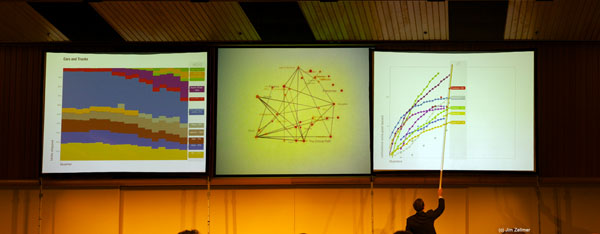The special chemistry of Boeing was one part the men and their originality of thought; one part a kind of corporate innocence that more than once left them outwitted by competitors with sharper elbows and lobbying skills in Washington, D.C.; and one part a stubborn adhesion to a place. Boeing Field resonated with the thunder of their own perfected science, the machines that increasingly became familiar at every airport around the world. This seemed like fulfillment enough: no need to swagger and strut, they seemed to feel; the jets are truly sexy and we own them.
It couldn’t last.
Daily Archives: February 2, 2013
Reaching for a Billion

Horace Dediu (asymco.com, interview) reaches for a billion users at Asymconf Silicon Valley 2013.
The Future According to Google Chairman Eric Schmidt
Anonymity: “Some governments will consider it too risky to have thousands of anonymous, untraceable and unverified citizens — “hidden people”; they’ll want to know who is associated with each online account, and will require verification at a state level, in order to exert control over the virtual world.
Schmidt has had an interesting relationship with privacy questions.
Global Trade: A view from the bridge
For one thing, the airborne share of trade is declining as the efficiency of seaborne trade grows. Los Angeles and Long Beach are spending over $5 billion between them on infrastructure to cope with ever-larger ships. Long Beach is building Middle Harbour, a 321-acre (130-hectare) container terminal that will be able to receive vessels of up to 18,000 TEUs. This month construction began on a replacement for the Gerald Desmond bridge, which will allow larger vessels to penetrate deeper into the harbour.
…….
Other developments may not help the west coast. The much-heralded expansion of the Panama Canal, now postponed until April 2015, will make room for vessels with a capacity of up to 13,000 TEUs (only tiddlers below 4,400 TEUs are now allowed). Over time that could mean a shift of business away from Long Beach to east-coast and Gulf of Mexico ports, though how much will partly depend on the canal’s fees and the capacity of these ports.
Anthony Otto, president of Long Beach Container Terminal, does not sound too concerned. Last year LBCT’s Hong Kong-based parent company placed a big bet on Long Beach’s future by taking out a 40-year, $4.6 billion lease at Middle Harbour. The transit times, facilities and cost structure at Long Beach, says Mr Otto, will ensure it stays the “preferred gateway” to American consumers for many shippers.
But some things the port can do little about. One is the growth of non-traditional trade routes (see article). The China-Brazil connection is increasingly vital. Pascal Lamy, head of the World Trade Organisation, has suggested that Africa could be China’s biggest trade partner within three to five years. Another challenge is “nearshoring”, the shift of manufacturing capacity closer to American consumers (see our special report). Mexico has been the big winner here: since 2010 it has outpaced China in increasing its exports to America. Most goods travel over land: fine news for truckers and trains, less so for ports.